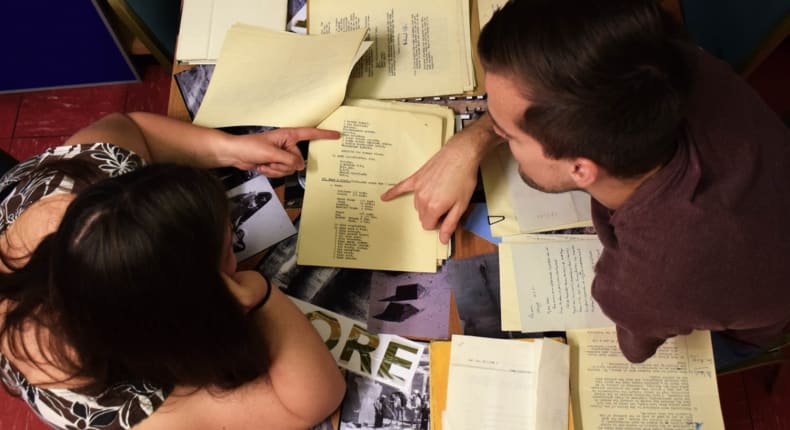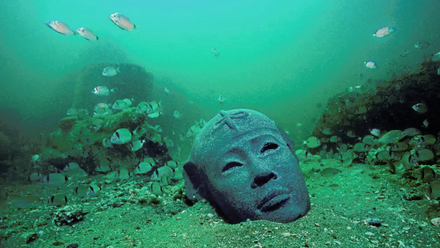Excavating Egypt: A recap
One of the highlights of this year’s calendar of events at the EES has been something a little outside the usual run of study days, evening classes, and lectures. After months of preparation, the EES’s pop-up exhibition, aptly titled Excavating Egypt, opened to the public for two weeks during the Council for British Archaeology’s annual Festival of Archaeology. Here Katherine Piper, one of the Society’s volunteers responsible for putting together the exhibition reflects.

Grenfell and Hunt outside their tent in the Fayoum inspired the choice of setting for the exhibition
During July 2015 the committee room at Doughty Mews was transformed into an archaeologists’ camp in the early days of the EES’s work, inspired by a wonderful photo in the Lucy Gura archive of Bernard Grenfell and Arthur Hunt sitting outside their tent whilst working at Oxyrhynchus in the Fayoum. Several wooden crates of various sizes were made for the exhibition, not only as part of the structure of the exhibition, but to add to the atmosphere of discovery and distribution! The purpose of the exhibition was to give a flavour of the process and experience of excavating in Egypt, from preparing for a season of work, to being on site in the full flow of excavation and everything that goes with it, to post-excavation writing-up and publication, all supported by material from the EES Lucy Gura archive from projects in Egypt and Sudan over the past 133 years. This was great opportunity to showcase some of the Society’s treasures which rarely sees the light of day, including photographs, letters, dig diaries and day-books, and promotional material such as posters for lectures or exhibitions.

Carl Graves and Ildiko Kalnoky investigate archive material for display
A display at the back of the room included original material, such as small watercolours of hieroglyphs painted by Marcus Blackden and Howard Carter at Beni Hasan in 1891, a letter from Amelia Edwards, the Amarna replicas made for John Pendlebury’s exhibitions in the 1930s, and Bryan Emery’s pay-bag. The Amarna replicas also formed part of an interactive element of the exhibition, provided by David Vacas Madrid, in which copies of the object cards for the original pieces and several of the pottery cards from Buhen were made into pictographic codes for anyone with the Augment app on their smartphone or tablet to scan, producing a 3D image of the object on their screen, which could be played around with – great fun for kids of all ages!
Another highlight of the exhibition was the short film taken by Michael Apted at Meir in Middle Egypt in 1950 and at Saqqara in 1951, titled, “To Work,” which showed a very scripted day in the life of the project working in the rock-tombs. This film, as well as being highly entertaining, provided a unique glimpse into the life of an archaeological project in Egypt, and really encapsulated the feeling of the exhibition as a whole, being constantly projected onto the screen of the “tent” in the centre of the room. The exhibition also marked the film’s world premiere, as the footage was only digitized in 2013 thanks to a donation from the Essex Egyptology Group, and is now available on the EES’s YouTube channel for all to see here.

Displays of original archival material complimented the overall theme of exploring Egypt
Some of the footage from the EES’s excavations at Amarna in the 1930s, directed by John Pendlebury, was also shown on the evening of Friday 17th July, when the EES director Dr Chris Naunton gave a talk about the footage and characters of the excavation, accompanied by a viewing of some archive material relating to those excavations, including original plans of the houses being excavated drawn up on site by Hilary Waddington. Other talks included a presentation on the scanning of the EES’s Amarna object card archive by Louise Atherton, a short lecture on Howard Carter’s early years in Egyptology with the EES by myself, and the ever-popular Hieroglyphs in Half an Hour classes taught by Ildiko Kalnoky.
Of course, there were more fun elements of the exhibition too – visitors were able to excavate their own authentic (modern) Egyptian scarabs in the pop-up excavation and make object cards, write their names in hieroglyphs on papyrus, and some also took part in the rather dubious activity of mummifying oranges, which was an interesting experience.
Overall, with visitors from as far afield as California and Australia, and as near as the other end of Doughty Mews, and overwhelmingly positive feedback, the exhibition was a great success. If you weren’t able to reach the exhibition in time, then all of the information panels and images from the displays are now available via the online exhibition at www.excavatingegypt.wordpress.com



